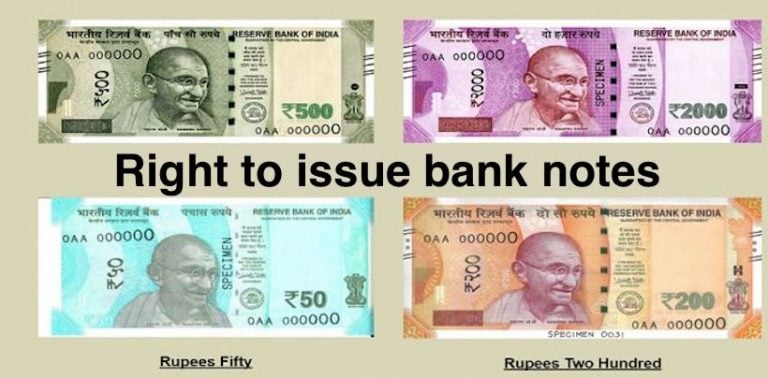Right to issue bank notes is one of the key central banking functions of the RBI. Section 22 of RBI Act confers RBI with sole right to issue bank notes in India. The issue function of bank notes is performed by the Issue Department, which is separated and kept wholly distinct from Banking Department. The RBI Act enables the RBI to recommend to Central Government the denomination of bank notes, i.e. two rupees, five rupees, ten rupees, twenty rupees, fifty rupees, one hundred rupees, five hundred rupees, one thousand rupees, two thousand rupees, five thousand rupees and ten thousand rupees or other denominations not exceeding ten thousand rupees.
The design, form and material of bank notes is approved by Central Government on the recommendations of Central Board of the RBI. Every bank note is a legal tender at any place in India, however, on the recommendation of the Central Board, the Central Government may declare any series of bank notes of any denomination as not to be legal tender. Another important function is the exchange of mutilated or torn notes, which under the RBI Act is not a matter of right, but a matter of grace. The bank notes that are being issued by RBI are exempt from payment of stamp duty.
Right to issue bank notes
Management of currency is one of the core central banking functions of the Reserve Bank for which it derives the necessary statutory powers from Section 22 of the RBI Act, 1934. Along with the Government of India, the Reserve Bank is responsible for the design, production and overall management of the nation’s currency, with the goal of ensuring an adequate supply of clean and genuine notes. In consultation with the Government, the Reserve Bank routinely addresses security issues and targets ways to enhance security features to reduce the risk of counterfeiting or forgery of currency notes.
The Paper Currency Act of 1861 conferred upon the Government of India the monopoly of issuing note, thus ending the practice of private and presidency banks issuing currency. Between 1861 and 1935, the Government of India managed the issue of paper currency. In 1935, when the Reserve Bank began operations, it took over the function of note issue from the Office of the Controller of Currency, Government of India.
Denominations of Notes
The Indian Currency is called the Indian Rupee (abbreviated as Re. in singular and Rs. in plural), and its sub-denomination the Paisa (plural Paise). At present, notes in India are issued in the denomination of Rs 5, Rs 10, Rs 20, Rs 50, Rs 100, Rs 200, Rs 500, and Rs 2,000. The printing of Rs 1 and Rs 2 denominations has been discontinued. However, notes in these denominations issued earlier are still valid and in circulation. The Reserve Bank is also authorised to issue notes in the denominations of five thousand rupees and ten thousand rupees or any other denomination, but not exceeding ten thousand rupees that the Central Government may specify.
Thus, in terms of Section 24 of RBI Act 1934, notes in denominations higher than ten thousand rupees cannot be issued. The Central Government may, on the recommendation of the Central Board, direct the non-issue or the discontinuance of issue of bank notes of such denominational values as it may specify in this behalf. The Government of India announced the demonetisation of Rs 500 and Rs 1000 bank notes with effect from midnight of November 8, 2016, making these notes invalid. A newly redesigned series of Rs 500 banknotes, in addition to a new denomination ofRs 2000 banknotes is in circulation since 10 November 2016.
Form of Bank Notes
The Department of Currency Management makes recommendations on the design of banknotes to the Central Government, forecasts the demand for notes, and ensures the smooth distribution of notes and coins throughout the country [Section 25]. It arranges to withdraw unfit notes, administers the provisions of the RBI (Note Refund) Rules, 2009 (these rules deal with the payment of the value of the soiled or mutilated notes), and reviews/rationalises the work systems and procedures at the issue offices on an ongoing basis.
Recommended
